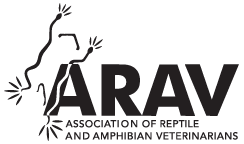Effect of Manual Restraint and Visual Security on Heart Rate in Dyeing Poison Dart Frogs (Dendrobates tinctorius azureus) and Leopard Frogs (Lithobates pipiens)
Abstract
Frogs are popular exotic pets and research subjects. Manual restraint is routinely used for basic procedures in frogs, including examination and sample collection, but there is little information on its physiologic effects in amphibians. Previous literature suggested that amphibians lack emotional responses and, therefore, consciousness, based upon an inability to elicit stress tachycardia with gentle handling. To determine if manual restraint results in a stress tachycardia in frogs, 10 poison dart frogs (Dendrobates tinctorius) and 8 leopard frogs (Lithobates pipiens) were manually restrained and heart rate (HR) recorded at both the pectoral girdle and pelvic patch using a Doppler flow probe. Frogs were randomly placed in one of two (opaque versus translucent) types of plastic containers for 22 min and HR measured every 2 min through the bottom of the container using the frogs' pelvic patch area. Frogs were then removed from the container, manually restrained again, and HR recorded. Heart rate decreased significantly after the frogs were placed in the containers following manual restraint, and increased significantly for the second restraint period. There were no significant differences in measured HR between anatomic sites (pelvic vs. pectoral) or container types. Contrary to previous descriptions, these results demonstrated that, similar to other mammal and reptile species, frogs demonstrated stress tachycardia during manual restraint, and, therefore, clinicians and researchers should be mindful of induced stress when restraining amphibians.
Introduction
Amphibians are popular pets and research models, yet many aspects of their basic physiology, in particular their response to stress, remain poorly studied. Understanding how amphibians acutely respond to stress is important, as the physiologic ramifications have the ability to confound research findings and can lead to increased morbidity and mortality. In amphibians, manual restraint is utilized for a variety of procedures, including physical examination, sample collection, diagnostic imaging, and medical treatment. Although it is well documented that restraint and other forms of handling induce acute stress in multiple animal groups, including reptiles (Cabanac and Bernieri, 2000; Cabanac and Cabanac, 2000), birds (Cabanac and Aizawa, 2000; Greenacre and Lusby, 2004), and mammals (Cabanac and Briese, 1992), handling failed to produce tachycardia in leopard frogs (Lithobates pipiens) and bullfrogs (Lithobates catesbeianus), leading to speculation that amphibians lack emotional responses, and subsequently consciousness, when compared to other animal groups (Cabanac and Cabanac, 2000; Cabanac et al., 2009). Recent studies examining corticosterone demonstrated that amphibians respond to stress similarly to other animal groups. For example, capture and manual restraint for toe-clipping resulted in a significant increase in urinary corticosterone metabolites in cane toads (Rhinella marina) (Narayan et al., 2011). Additionally, Fijian ground frogs (Cornufer vitianus) that were placed near cane toads, a natural predator, demonstrated a significant increase in corticosterone metabolites when compared to controls, indicating a stress response secondary to a perceived visual threat (Narayan et al., 2013). These recent studies in amphibians have focused on changes in corticosterone concentrations associated with handling rather than the immediate, sympathetic nervous system–driven effects on the cardiorespiratory system. This led us to question whether amphibians demonstrate the same acute indicators of stress (e.g., tachycardia) observed with manual restraint in other animal groups.
The objectives of this study were to determine if frogs demonstrate an acute stress response secondary to manual restraint using heart rate (HR) as a noninvasive indicator and to determine if an acute stress response occurs with changes in visual security from the observer. Two species commonly encountered in veterinary practice or research settings, dyeing poison dart frogs (Dendrobates tinctorius) and leopard frogs (Lithobates pipiens), were used for the study. Because of the small size and speed of these frog species, manual restraint is routinely utilized for safe handling and examination. We hypothesized that both frog species would demonstrate a stress tachycardia associated with both manual restraint and an absence of visual security from the observer.
Materials and Methods
This study was approved by the University of Wisconsin–Madison, School of Veterinary Medicine Institutional Animal Care and Use Committee. Captive-born dyeing poison dart frogs (N = 10) and leopard frogs (N = 8) of unknown age and sex were utilized in this study. Median (range) body weights were 2 g (1–2 g) and 43 g (17–58 g) for the dart and leopard frogs, respectively. The frogs were housed in conspecific pairs in plastic laboratory rodent enclosures with moistened New Zealand sphagnum moss as a substrate. The frogs were provided a hide box and water ad libitum. The enclosures were misted daily with distilled water and humidity was maintained above 92%. Ambient holding room temperature was maintained between 23.9 and 28.0°C (75.0–82.4°F). Animals were fed daily. The dart frogs were fed fruit flies and the leopard frogs were fed adult crickets. Insects were gut-loaded and dusted with a commercial calcium supplement before daily feeding, and weekly with commercial multivitamin and vitamin A supplements. Each frog was deemed healthy based on examination at the beginning of the study and no health abnormalities were observed throughout the experimental trials.
On the day of trials, frogs were maintained between 26 and 27°C (78.8 and 80.6°F) and allowed to acclimate to the experimental room for 20 min prior to obtaining physiologic measurements. Frogs were manually restrained by the same observer (CJ), and HR was measured using a pencil Doppler flow probe (Ultrasonic Doppler Flow Detector, Parks Medical Electronics Inc, Aloha, OR). All Doppler HR measurements were recorded using headphones. Two HR measurements were performed under the initial manual restraint period, one with the probe placed against the ventral pectoral girdle and another with the probe placed against the caudoventral coelom (Fig. 1). The anatomic site of first measurement (coelomic or pectoral) was randomized using free online software (Research Randomizer Version 4.0; www.randomizer.org). Two HR measurements were performed in order to validate that a Doppler flow probe recording from the caudoventral coelom was indicative of true HR rather than inadvertent recording of a lymph heart. If the HR was not successfully obtained within 30 sec of capture, the frog was returned to its holding enclosure and the trial reattempted a minimum of 3 h later.



Citation: Journal of Herpetological Medicine and Surgery 31, 1; 10.5818/20-00021.1
To evaluate the effect of visual security on HR, dart frogs were placed into either a translucent (60 ml [2 oz] clear polypropylene portion cup, Karat, Chino, CA, USA) or opaque, black plastic (60 ml [2 oz] black polypropylene portion cup, Karat) container with a translucent lid in a randomized crossover design with a minimum of 7 days between trials. Leopard frogs were placed in larger, 235 ml (8 oz) translucent or opaque, black plastic deli containers. Containers were positioned to permit HR measurement through the plastic bottom of the container using the Doppler pencil probe coated with ultrasound transmission gel (Fig. 2). For animals in translucent containers, the position of the frog inside the container was obvious and the probe was placed against the portion of the container bottom immediately adjacent to the frog's caudoventral coelom. The translucent container permitted light and shadow transmission, and HR measurements required the observer to be within 30–45 cm (12–18 in) of the frog.



Citation: Journal of Herpetological Medicine and Surgery 31, 1; 10.5818/20-00021.1
For frogs in opaque containers, an apparatus was constructed to permit HR measurement without the frog being able to see observer movement or shadows (Fig. 3). The apparatus permitted localization of the frog within the container by the observer through use of a live video feed (Hero4, GoPro Inc., San Mateo, CA, USA) displayed on a tablet (iPad Pro, Apple Inc., Cupertino, CA, USA).



Citation: Journal of Herpetological Medicine and Surgery 31, 1; 10.5818/20-00021.1
After the frog was placed into the container, HR was measured every 2 min for a 20-min period. At 22 min, frogs were removed from the containers and manually restrained to obtain both pectoral and coelomic site HR as previously described. Frogs were returned to their enclosures at the end of the trial.
Statistical analysis
The data were analyzed using commercial statistical analysis software (SigmaPlot, Access Softek, Berkeley, CA, USA). The data were tested for normality using the Shapiro–Wilk test and for equal variance using the Brown Forsythe test. If data were not normally distributed, they were simple transformed or rank transformed, if necessary, prior to further analysis. Heart rate between treatments and Doppler reading site were compared using a two-way, repeated-measures analysis of variance. The Holm–Sidak method was used for post hoc pairwise comparisons if significant differences were determined between treatments. Data not normally distributed were reported as median and interquartile range (IQR); normally distributed data were reported as mean ± SD. Differences were considered statistically significant at values of P < 0.05.
Results
There were no clinically relevant or statistically significant (P = 0.716) differences in HR between measurement sites (ventral coelomic, pectoral) in either frog species for either time point (0 and 22 min).
Heart rate decreased significantly over time in both treatment groups for both frog species after the initial manual restraint period. For dart frogs, mean HR decreased by a maximum of 38% (−35% to −22%) for the opaque containers and by 35% (−35% to −26%) for the translucent containers (Fig. 4). In leopard frogs, median HR decreased by a maximum of 32% (−32% to −18%) for the opaque containers and by 30% (−29% to −14%) for the translucent containers (Fig. 5). During the second restraint period (22-min time point) there was a statistically significant HR increase (P ≤ 0.01) in both species. There were no statistically significant differences in mean HR between container type for either species.



Citation: Journal of Herpetological Medicine and Surgery 31, 1; 10.5818/20-00021.1



Citation: Journal of Herpetological Medicine and Surgery 31, 1; 10.5818/20-00021.1
Discussion
Based on the results of this study, dart and leopard frogs develop stress tachycardia in response to manual restraint, similar to other animal species. The findings of this study are in contrast to an earlier study in bullfrogs and leopard frogs, which showed no stress-induced tachycardia (Cabanac and Cabanac, 2000). In that study, HR did not significantly change in bullfrogs and leopard frogs when placed in the palm of an observer's hand and rocked gently (Cabanac and Cabanac, 2000). However, the gentle handling performed in that study is distinct from manual restraint, which has been compared to predation in birds (Silverin, 1998).
Development of stress tachycardia in the dart and leopard frogs in this study reinforces the notion that manual restraint should be performed cautiously in debilitated amphibians just as in other species, considering the significant effect of the acute-onset fight-or-flight response on the cardiovascular system. Researchers should be cognizant of the fact that manual restraint may have negative consequences on physiologic variables and the hormonal changes secondary to activation of the hypothalamic–pituitary–adrenal axis in amphibians.
Visualization of a predator resulted in a significant increase in corticosterone concentrations indicating a stress response in Fijian ground frogs (Narayan et al., 2013). In this study, dart and leopard frogs placed in transparent containers, with a subsequent lack of visual security, did not display statistically significantly higher resting HR when compared to frogs in opaque containers. There are several potential explanations for this finding. One possibility is that both species did not interpret the human observer as a potential predator, despite close proximity to the frogs during HR readings. Caretakers routinely fed but did not regularly restrain the frogs, so it is possible some acclimatization to human presence occurred. Also, the plastic of the transparent container may have partially distorted the frogs' vision and prevented olfactory cues, which could explain the lack of observed change in HR during Doppler readings. Alternatively, it is possible that the frogs interpreted the observer as a predator, with activation of the hypothalamic–pituitary–adrenal axis but not a more acute sympathetic response resulting in a stress tachycardia. Further research is required to draw conclusions regarding the effect of visual security on the sympathetic response to stress in amphibians.
Doppler HR measurement is a common procedure used in clinical amphibian medicine, most commonly performed using manual restraint or during sedation and anesthesia. Results of this study demonstrate that HR can be measured in awake frogs of different sizes with a Doppler flow probe through a thin plastic surface if transducer gel is used, which permitted measurement of nonrestrained HR more closely reflecting resting HR. Additionally, HR measurements performed in the area of the caudoventral coelom (i.e., the pelvic patch) provided results consistent with those obtained by placing the probe directly adjacent to the heart. This site can be a useful alternative for nonrestrained HR measurement in species that sit with their cranial coelom elevated off the ground (e.g., dendrobatid frogs).
Similar to mammals, birds, and reptiles, brief periods of manual restraint elicit an acute, stress tachycardia in dart and leopard frogs. Changes in visual security did not have a significant effect on resting HR in either frog species. Unrestrained Doppler HR measurement can be performed in frogs through thin plastic using transducer gel and can permit collection of HR more representative of resting values. Results of this study highlight that manual restraint is not a benign procedure and handlers should be aware of its physiologic ramifications, especially when working with debilitated frogs or conducting research.

Measurement of heart rate using a Doppler pencil probe in a restrained dyeing poison dart frog. Heart rate is measured by placing the probe over the pectoral girdle (A) and in the area of the pelvic patch or caudoventral coelom (B).

Measurement of heart rate through a translucent, plastic deli container in a nonrestrained leopard frog (Lithobates pipiens) using a Doppler pencil probe coated with transducer gel. Heart rate is measured by placing the probe adjacent to the pectoral girdle.

Measurement of heart rate (HR) through an opaque, plastic deli container in a nonrestrained dyeing poison dart frog (Dendrobates tinctorius azureus) using a Doppler pencil probe coated with transducer gel. The deli container was placed inside an apparatus constructed to permit HR measurement without the frog being able to see observer movement or created shadows. The housing permitted the observer to localize the frog within the container by use of a live video feed.

Mean (±standard error of the mean) heart rate (HR) in dyeing poison dart frogs (Dendrobates tinctorius azureus) manually restrained for HR measurement (0-min time point) then placed in plastic containers. Once in the plastic containers, nonrestrained HR measurements were performed every 2 min until frogs were removed from the containers and manually restrained a second time for HR measurement (22-min time point). To evaluate the effect of visual security on HR, frogs were placed into either a translucent (white circles) or opaque plastic container (black circles).

Median (±25th and 75th percentiles) heart rate (HR) in leopard frogs (Lithobates pipiens) manually restrained for HR measurement (0-min time point) then placed in plastic containers. Once in the plastic containers, nonrestrained HR measurements were performed every 2 min until frogs were removed from the containers and manually restrained a second time for HR measurement (22-min time point). To evaluate the effect of visual security on HR, frogs were placed into either a translucent (white circles) or opaque plastic container (black circles).



